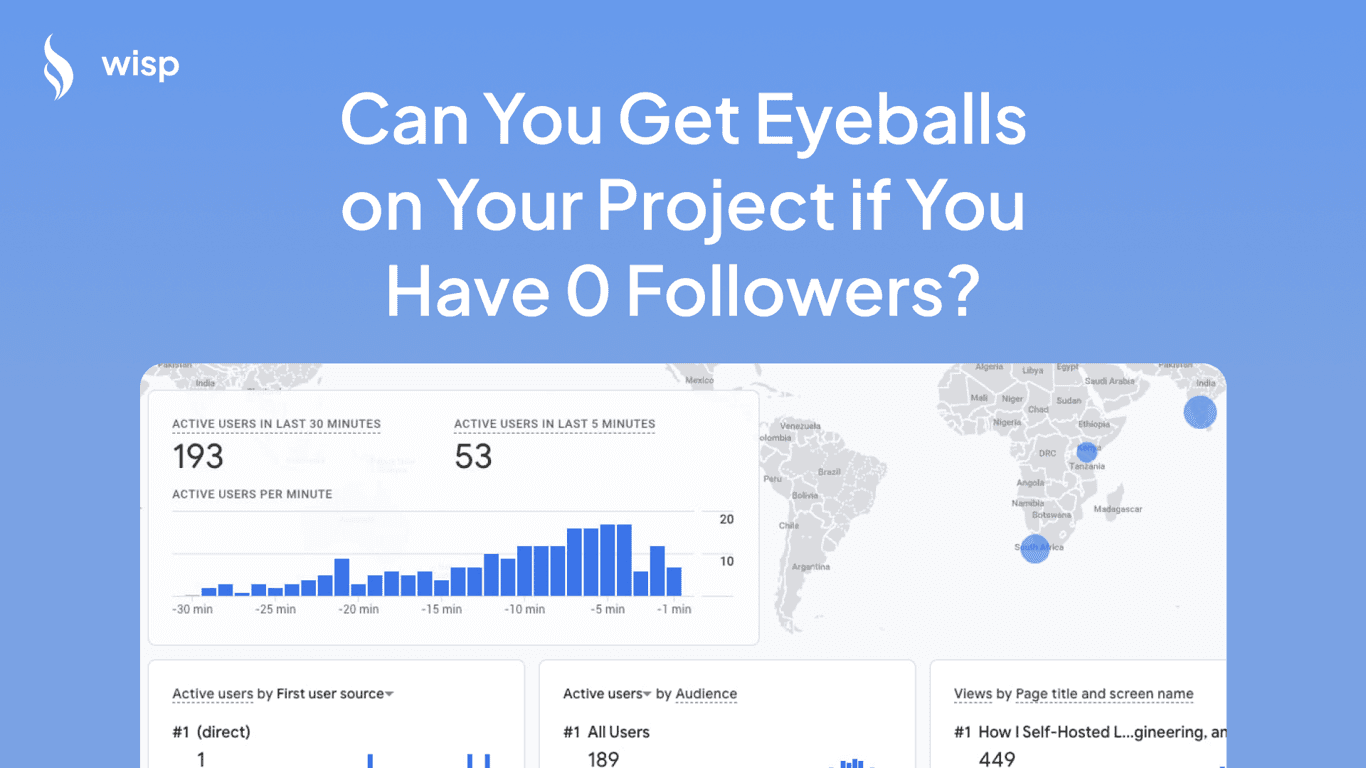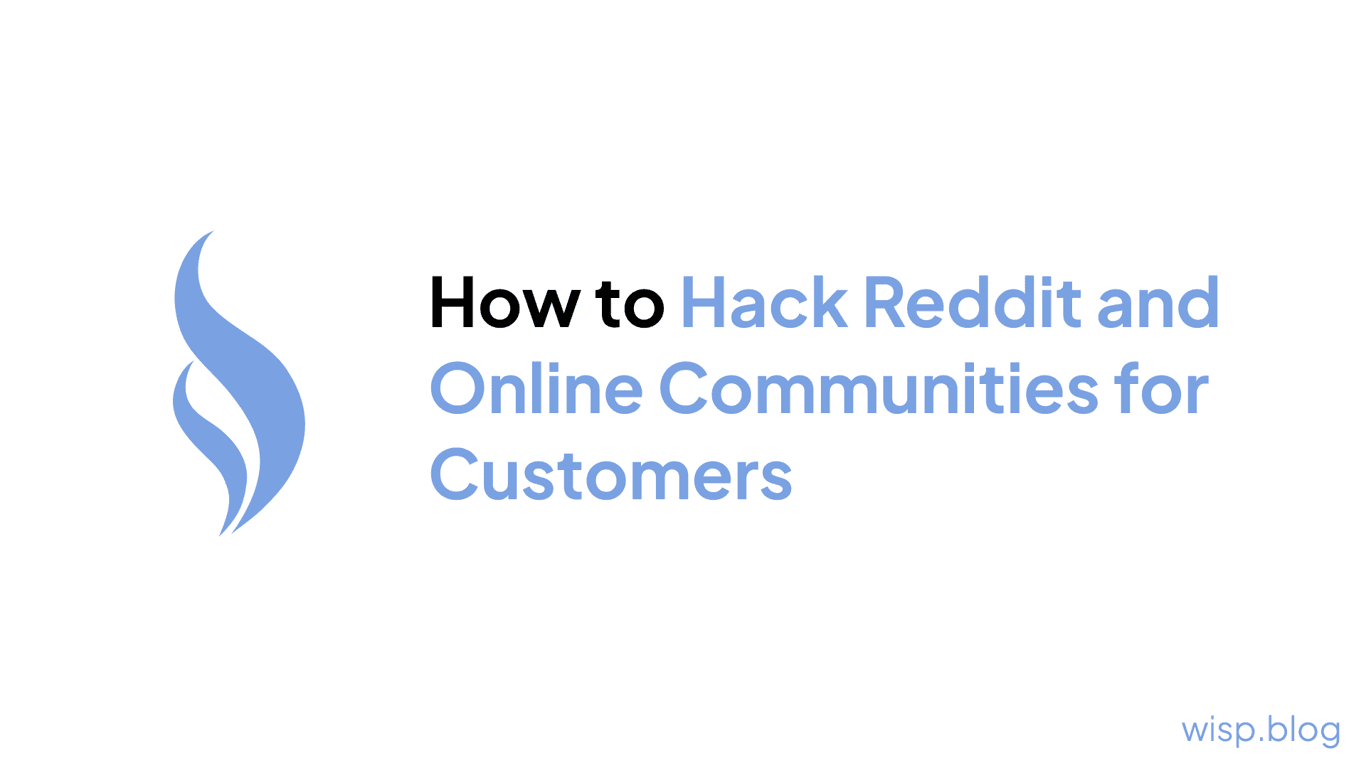
As an indie hacker, you've been constantly told to #buildinpublic, but as you tweet out your progress, your voice echoes into the void, unanswered. You've been grinding away on your SaaS project for months, pouring your heart and soul into building something you truly believe in. But no matter how many features you ship or how much you polish your product, it feels like nobody is paying attention.
You know having an engaged audience is critical for getting feedback, building buzz, and ultimately finding those first few customers crazy enough to pay you. But getting eyeballs on your work feels like banging your head against the wall. How are you supposed to cut through the noise when you're just one indie hacker among millions?
If you tweet it, they will follow?
It's incredibly frustrating to have so much passion for what you're building, yet struggle to get it in front of the right people. You've tried posting screenshots, sharing your journey, asking questions - but your tweets just get lost in the endless feed. Meanwhile, you see other solopreneurs and makers effortlessly racking up hundreds of likes and retweets, building audiences of thousands of engaged followers.
You can't help but wonder what you're missing. Is your product not compelling enough? Are you not leveraging the right hashtags and tactics? Or is Twitter just an oversaturated waste of time for bootstrapped indie projects?
The self-doubt starts creeping in. You're proud of what you've built so far, but if nobody outside your inner circle sees it or cares, what's the point? Pivoting to another idea or just keeping it as a side project is starting to look more appealing than wasting more energy into this Twitter black hole.
You can build a tribe without being "the shady guy"
What if I told you that not only is Twitter an incredibly powerful channel for indie hackers like yourself, but that you can realistically build an audience of over 1,000 engaged, relevant followers in just a few months? And you can do it without any shady tricks, buying followers, or being "that guy" who constantly shills his product.
The key is understanding how to strategically insert yourself into the existing indie hacker community on Twitter. By providing value, engaging with the right people, leveraging Twitter's unique functionality, and cracking the code of the algorithm, you can rapidly build a loyal tribe who will support your journey and become your first customers.
Phase 1: Building Your Engagement Foundation (0-500 Followers)
The first phase is all about establishing a solid foundation of engagement within your niche on Twitter. This will allow you to get on the radar of potential followers and start building familiarity.
1. Create an Engagement List
Start by creating a private Twitter list titled something like "Indie Hackers to Engage With." Populate this list with at least 50 accounts that have high engagement (lots of likes, retweets, replies) within your specific niche.
For example, if you're an indie hacker building a no-code tool, you'd search for top accounts posting about #nocode, #webflow, #bubble and add the most engaging ones to your list. Look for accounts that are consistently getting hundreds of likes and retweets.

Pro-Tip: Use Twitter's advanced search operators to find high-engagement accounts and content. Search queries like "webflow min_faves:50 min_retweets:20" will surface popular tweets in that space.
2. Follow and Engage Proactively
Once you've built out your engagement list, follow all of the accounts on it. Then, turn on notifications for their tweets so you can start engaging with them in real-time.
The key here is to avoid generic comments and actually contribute value to the conversation. Read their tweets carefully, put thought into your responses, ask insightful follow-up questions, and engage with authenticity, humor, and friendliness.
For example, if someone shares a struggle around finding no-code developers, you could respond with:
Oof, that's a tough one! I've had some luck finding devs for my project on [site]. But you really have to vet them thoroughly on [criteria].
Don't pitch or promote your product at all during this phase. Just focus on building familiarity and becoming a recognized, trusted voice in these conversations.
Common Pitfall: Using bot automation tools that leave generic comments and retweets. This comes across as insincere and spammy. Stick to engaging manually.
3. Follow Followers (Strategically)
Each week, follow 100 new accounts who are following the people on your engagement list. These are your "tribe" - people who are passionate about your niche and likely to be interested in what you're building.
For example, if you notice the @Webflow account is on your engagement list, you could view their followers and follow 100 accounts that seem relevant each week.
To manage your follow/follower ratio (which can impact Twitter's perception of your account), you can use tools like Crowdfire, Unfollow.io or similar tools to remove any accounts that don't follow you back after a week or so.
4. Expand and Diversify Your List
As you engage more, you'll start to discover new accounts that are also highly active and engaging in your niche. Add these accounts to your engagement list to expand your reach.
You can also explore Twitter's topics, categories, and hashtags related to your interests to find even more relevant accounts to engage with and add to your list.
For example, if you're building a Notion tool, you could explore the #NotionCommunity topic and related hashtags to find more accounts to engage with.
Common Pitfall: Only engaging with the same, insular group of accounts. This limits your visibility and prevents you from reaching new audiences. Actively look to expand your engagement list.
5. Nurture New Followers
When someone follows you, send them a kind, personalized direct message to express gratitude and welcome them to your journey. Don't ask for anything in return - just focus on building a genuine connection.
For example:
Thanks for the follow! Just wanted to say hi and that I'm stoked to have you join my indie hacking journey. Looking forward to sharing more updates and insights as I continue building [product name]!
Pro-Tip: You can use Twitter's advanced search to find your newest followers with queries like "filter:follows" and then bulk DM them from there.
The key to Phase 1 is putting in the consistent work to build a foundation of engagement, familiarity, and mutual respect within your niche's community. It's a grind, but those 500 followers you build will be highly relevant and much more engaged than any amount of bought followers.
Phase 2: Unleashing Engagement Threads (500-1,000 Followers)
Once you've built an initial audience of around 500 engaged, relevant followers, it's time to start leveraging Twitter's most powerful reach tool: threads. Thoughtful, compelling threads can get massively amplified visibility and engagement from your existing audience.
6. Create a Swipe File
Before crafting your own threads, it's helpful to create a "swipe file" of effective tweets and threads from others in your niche. This will allow you to analyze what works and reverse-engineer successful formats and styles.
To build your swipe file, set up a private Twitter list titled something like "Thread Inspo" and populate it with accounts that consistently create engaging threads. Anytime you see a particularly compelling or viral thread, retweet it to your list.
You can also use Twitter's search operators to find popular threads on specific topics or with certain levels of engagement. For example:
indie hackers min_retweets:100 min_faves:500
This will surface tweets about indie hackers that have over 100 retweets and 500 likes - indicating strong engagement.
Pro-Tip: Create separate lists or categories in your swipe file for different thread styles and topics. For example, "Thought Leadership Threads", "Educational Threads", "Storytelling Threads", etc.
Common Pitfall: Not studying what works before trying to create your own viral threads. Your swipe file allows you to deconstruct proven examples of success.
Additional note: I personally keep my swipe files on a note on Obsidian, you can choose your favourite notetaking platform for this step.
7. Craft Epic Threads
An "epic thread" is a series of 5-10 tweets that are connected into a single, compelling narrative or argument. Each tweet should build curiosity and anticipation for the next one, keeping your audience hooked until the very end.
For example, if you're building a tool for indie hackers, you could create a thread titled:
"Want to be an indie hacker? Here are the 10 skills you need to master:
Tweet [1/10]: You need insane product instincts to deeply understand your audience's needs and how to craft solutions they'll pay for.
Tweet [2/10]: You must learn to code - not just hack together scripts, but build secure, scalable software from the ground up.
...and so on for 8 more skill-focused tweets."
The more unique, bold, and specific the perspective you share, the more your audience will feel compelled to read, engage with, and share your thread.
Pro-Tip: Study other popular threads in your niche to reverse-engineer effective formats and styles. You can retweet them to save and reference later.
Common Pitfall: Only creating short, surface-level threads. The most engaging ones are epically long, telling a story or arguing a strong point over many tweets.
8. Collaborate and Leverage
Contributors Don't go it alone when creating threads. Collaborate with others by involving them in the creation process and tagging them throughout the thread.
Reach out to relevant people via DM with something like:
Hey [name]! I'm putting together an epic thread on [topic] and think you'd have some awesome insights to include. Any chance you'd be interested in contributing a couple of points? I'll make sure to tag you in the thread!
Getting other respected voices involved will amplify your thread's visibility and engagement right off the bat.
9. Optimize for the Algorithm
While the latest changes to Twitter's algorithm remain mysterious, we do know that certain actions can significantly boost a tweet's visibility and prominence:
Replies are the most heavily weighted signal, so engage in meaningful conversations by replying promptly to anyone who comments on your thread
Likes and retweets still play a role, so encourage your audience to engage in those ways
Limit sharing external links, as Twitter may flag them as spam (unless you have enough engagement to counteract it)
Consider upgrading to Twitter Blue for increased visibility limits
Most importantly, create your threads and content hyper-focused on your specific niche. Straying too far outside of your core cluster can negatively impact performance.
Phase 3: Nurturing Your Tribe (1,000+ Followers)
By executing the first two phases consistently over 2-3 months, you should be able to build an audience of over 1,000 highly-relevant, engaged followers who are aware of your indie project. Now it's time to nurture that tribe and continue growing your momentum.
9. Sustain Proactive Engagement
Don't let your engagement drop off just because you've hit 1,000 followers. Continue proactively engaging with your tribe, adding new accounts to your engagement lists, and building familiarity with potential followers.
For example, if you notice someone in your niche sharing a insightful tweet, engage with it by asking a follow-up question or providing a complementary perspective. This keeps you top-of-mind with your audience.
Respond to every reply on your threads, continue collaborating with others on their content, and always be on the lookout for opportunities to provide value through your expertise.
Pro-Tip: Set aside 30 minutes each day specifically for proactive engagement. This could be first thing in the morning or during a break to ensure it gets prioritized.
Common Pitfall: Letting your engagement become one-sided, where you're just broadcasting content without interaction. This will cause your tribe to lose interest over time.
10. Publish Threads Consistently
Now that you've built an audience, you need to continue feeding them a steady stream of epic, insight-packed threads to maintain momentum. Aim to publish a new high-quality thread every 1-2 weeks.
For example, you could create a recurring "Work in Progress Wednesday" thread where you share behind-the-scenes looks and challenges you're facing in building your product that week.
The key is making these threads as insightful, bold, and specific to your niche as possible. Don't be afraid to take controversial stances or share unconventional perspectives - this will spark more engagement.
Pro-Tip: Create a shared Google Calendar with content themes and ideas plotted out for the next few months. This makes it easier to batch upcoming thread content.
Common Pitfall: Letting your content become stale or rehashing the same insights over and over. Your tribe will lose interest quickly if you don't continue leveling up the value you provide.
11. Share Your Journey
In between threads, share more "breadcrumb" style posts that give your audience behind-the-scenes glimpses into your indie hacking journey. Show off new features, share code snippets, discuss challenges you're facing, and continue sparking curiosity about what you're building.
For example, you could share a GIF of a new feature with a caption like:
Shaving hours off this workflow for indie hackers 😎 ̿̿ ̿̿ ̿̿ ̿'̿'̵з=༼ ▀̿̿Ĺ̯̿̿▀̿ ̿ ༽
The more you build in public and share your journey, the more your tribe will feel invested in your success and excited to support you.
Pro-Tip: Create a "Shipping" Twitter list of your followers who seem most engaged, then @mention that list when sharing major updates or launches. This ensures your biggest fans don't miss it.
Common Pitfall: Sharing too many breadcrumb posts back-to-back without any longer-form, substantive content. Your audience will tune out if you don't continue providing epic value.
12. Identify Micro-Influencers
As your tribe grows, you'll notice certain members who are particularly engaged - liking and retweeting all your content, jumping into every conversation, and expressing enthusiasm for your work.
Identify these micro-influencers and spend extra time nurturing those relationships. Collaborate with them on threads, give them a sneak peek at upcoming features, and ask for their feedback often.
They could become powerful evangelists, affiliates, and potentially your first customers down the road. Treat them like VIPs.
Pro-Tip: Create a separate private Twitter list for "Superfans" where you'll move your most engaged followers. This allows you to easily monitor and nurture those relationships.
Common Pitfall: Ignoring your biggest supporters and treating them like regular members of your audience. They'll feel unappreciated and potentially take their support elsewhere.
13. Leverage Your Tribe
Don't be afraid to start calling on your tribe for support as you continue building your indie business. Ask for feedback on new features, share beta invites and get them to test your product, or see if any of them would be interested in providing testimonials or reviews.
For example, you could create a Twitter poll asking your audience: "What's the #1 feature you'd like to see next in [product]?" Then create a thread sharing the results and your thoughts on addressing the top picks.
The more you treat your tribe as invested partners in your journey (not just another audience to broadcast to), the more they'll go to bat for you and help amplify your message.
Pro-Tip: Identify the most engaged members of your tribe and DM them individually with exclusive opportunities like beta testing, feedback calls, etc. This makes them feel valued.
Common Pitfall: Constantly asking for feedback, support, or promotion without providing your tribe with an incredible amount of value first. Don't take more than you give.
By nurturing your tribe of 1,000+ followers through consistent engagement, epic content, and making them true partners in your journey, you'll be able to foster a powerful force-multiplier for your indie business. Over time, your tribe will continue growing exponentially through their advocacy and word-of-mouth alone.
A quick recap
Building an audience of over 1,000 passionate, engaged followers on Twitter is a monumental achievement for any indie hacker. But as you've seen, it's very much an attainable goal through strategic networking, engagement, and leveraging Twitter's unique functionality.
Here's a quick checklist recap for each phase:
Phase 1 Checklist:
Create an engagement list of 50+ relevant, active accounts
Follow those accounts and proactively engage with value
Follow followers of your engagement list accounts
Continuously expand and diversify your engagement list
Nurture new followers with personal outreach
Phase 2 Checklist:
Build a swipe file of effective tweets and threads
Craft epic, insight-packed threads (5-10 tweets long)
Collaborate with others and leverage contributors
Optimize threads for maximum algorithm amplification
Phase 3 Checklist:
Sustain proactive engagement with your tribe
Publish new high-quality threads every 1-2 weeks
Share behind-the-scenes "breadcrumbs" of your journey
Identify and nurture relationships with micro-influencers
Leverage your tribe for feedback, beta testing, promotion
By nurturing your tribe of 1,000+ followers through consistent engagement, epic content, and making them true partners in your journey, you'll be able to foster a powerful force-multiplier for your indie business. Over time, your tribe will continue growing exponentially through their advocacy and word-of-mouth alone.
It takes work, yes. But the potential to build an engaged audience of evangelists who will help make your indie dreams a reality makes it a no-brainer investment for any bootstrapped founder. Embrace the journey, stay consistent, and watch your tribe grow into an unstoppable force for your business's success.


